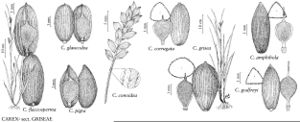Carex grisea
Kongl. Vetensk. Acad. Nya Handl. 24: 154. 1803.
Plants densely cespitose; rhizome internodes 1.2–2 mm thick. Culms dark purple-red to 2–3.2 cm high or rarely brown at base, 15–90 cm. Leaves: sheaths glabrous; blades green, widest blades (3.7–)4.2–8.2(–9.1) mm wide, smooth abaxially. Inflorescences 0.38–0.85 of culm height; peduncles of lateral spikes smooth or barely scaberulous; peduncles of terminal spikes 1.6–22(–51) mm, usually barely exceeding lateral spikes; proximal bract sheath loose, abaxially glabrous, sheath front slightly concave to slightly convex, elongated 0.7–2.5(–4.4) mm beyond apex; ligules (1.8–)3–7.5(–11.2) mm; distal bract slightly exceeding or rarely much exceeding terminal spike. Spikes (3–)4–5(–6), distal 2–4 overlapping; lateral spikes pistillate or rarely androgynous, with 3–19 perigynia, 5–31 × 6.7–11.4 mm, ratio of spike length (in mm) to flower number =1.6–2.1(–2.8); terminal spikes 7–35 × 1.5–3.1 mm. Pistillate scales 4–8.2 × 2.1–2.6 mm, margins whitish, usually with red-brown speckles, entire, apex with awn 0.9–5.3 mm. Staminate scales 2.7–5 × 1.1–2.1 mm. Anthers 2.3–3.3 mm. Perigynia spirally imbricate, 52–64-veined, unwrinkled, narrowly ellipsoid to obovoid, orbicular or suborbicular in cross section, (4.2–)4.5–5.1(–5.3) × (1.8–)2–2.6 mm, 1.8–2.3(–2.6) times as long as wide, lustrous, base very gradually tapered, apex gradually tapered; beak absent or straight, 0–0.2 mm. Achenes broadly obovoid to obovoid, widest at 0.6–0.66(–0.7) of body length, (2.6–)3.1–3.5(–3.7) × 1.7–2.1(–2.2) mm, loosely enveloped by perigynia; stipe straight, (0.2–)0.3–0.4(–0.5) mm; beak straight, (0.2–)0.3–0.6 mm.
Phenology: Fruiting spring–summer.
Habitat: Mesic deciduous forests and forest openings, most often in sandy and calcium-rich alluvia on flood plains
Elevation: 10–400 m
Distribution

N.B., Ont., Que., Ark., Conn., Del., D.C., Ill., Ind., Iowa, Kans., Ky., Maine, Md., Mass., Mich., Minn., Miss., Mo., Nebr., N.H., N.J., N.Y., Ohio, Okla., Pa., S.Dak., Tenn., Tex., Vt., Va., W.Va., Wis.
Discussion
Carex grisea is a common and widespread species that grows frequently with C. amphibola and infrequently with C. corrugata. When growing near the other species, C. grisea usually inhabits sandier soils than them. Also, the usual habitats of C. grisea are less acidic than those of C. amphibola.
Selected References
None.
